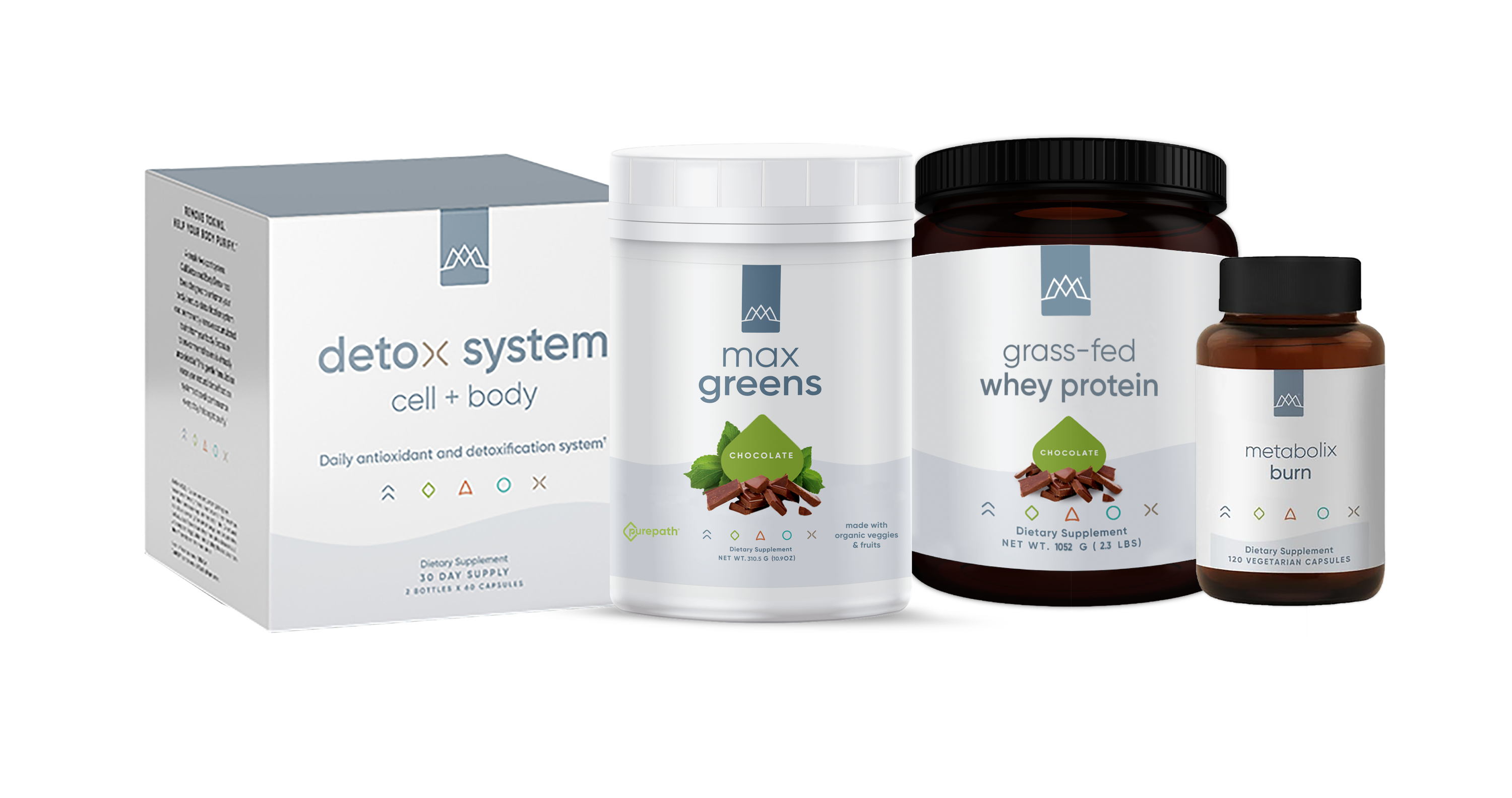
MaxLiving Perspective
Incorporating 5 Essentials™
Metabolism Perspective
Core Chiropractic
Get a chiropractic adjustment. The underlying premise of chiropractic care is to remove interference in the central
nervous system, as it controls and coordinates all the functions of the body, including your metabolism.(2)
Nutrition
Eat protein for breakfast. Protein for breakfast, such as eggs or a high-quality protein powder, can jump-start the
day, keep you fuller longer, and help prevent excess calorie intake later in the day. (3)
Avoid sugar and refined carbohydrates. Sugar and refined carbohydrates are high on the glycemic index and digested
quickly, meaning they lead to short-term fullness and are not sustaining throughout the day.(4)(5)
Don’t use artificial sweeteners. Although artificial sweeteners, such as aspartame and sucralose, typically have very
few or zero calories, their sweet taste can cause unnecessary insulin release in the body, which can lead to increased
fat storage and weight gain.(6,7) Instead, use natural sweeteners, such as stevia.
Spice up your food. Spicy foods contain a compound called capsaicin, which helps to boost metabolism and decrease
cravings. (8)
Drink at least 8 glasses of clean, filtered water per day. Water can help boost metabolism and increase the amount
of calories burned per day, resulting in fat loss. (9)
Avoid most beverages except water. Beverages, especially sodas, diet sodas, sugary alcoholic drinks, and flavored
coffee drinks are high in added sugar or artificial sweeteners, high in calories, and do not contain nutrients to keep
the body full. (10) It is also very easy to unknowingly consume extreme amounts of sugar very rapidly.
Mindset
Learn to manage stress. Stress contributes to weight gain due to multiple factors, including increased levels of cortisol and emotional eating.(11)
Get at least 7-9 hours of sleep per night. (12) Sleep is fuel for the brain, and the lack of sleep may alter metabolic
processes, increase appetite, and encourage poor eating choices during the day.(13)(14)
Oxygen & Exercise
Exercise regularly. Exercise has many benefits, including fat loss and muscle building. (15)(16) Aerobic exercises, such as swimming, jogging, and biking, or high-intensity, short-duration exercises have shown promising results. (16)(17)(18)(19) Strive to exercise for at least 30 minutes, 3-4 times per week.
High- Intensity and strength training. High-intensity and strength training workouts help you burn more fat by increasing your metabolic rate. This type of exercise involves exercising for a short period of time at a high intensity, usually in intervals. It utilizes what’s called “metabolic conditioning” to enhance fat burning. Because of the high-intensity workouts, metabolic conditioning helps burn fat and calories both during and after the workout.(20)
Please consult with your healthcare practitioner before starting any exercise program.
Minimize Toxins
Use toxin-free beauty and cleaning products. Exposure to chemicals, like lead, can contribute to obesity and
obesity-related diseases. (21) In fact, the rise of obesity has been found to possibly correlate with an increase industrial chemicals over the past four decades. Endocrine-disrupting chemicals could be linked to the obesity epidemic, a term researchers call “obesogens.”(22)

Functional Nutrient & Toxicity Testing
MaxMetabolix testing identifies the root cause of your body’s nutrient deficiencies, toxicities, and genetic susceptibilities. Speak with your MaxLiving Doctor about starting your MaxMetabolix program.
Metabolism Bundle Recommended Use
- Take 2 capsules of Cell Detox 30 minutes before breakfast.
- Drink 1 protein shake with Grass-Fed Whey protein and Max Greens.
- Take 2 capsules of Metabolix Burn with breakfast.
- Take 2 capsules of Metabolix Burn with lunch.
- Take 2 capsules of Body Detox 1 hour before bedtime.

Nutrient Support*
Talk to your healthcare practitioner about including these and/or any other nutraceuticals in your dietary practices.
Never modify any medications or other medical advice without your healthcare practitioner’s support.
For best results, our Daily Essentials for Men or Women combine five essential supplements and have been formulated in convenient, easy to use packets! These packets contain a
Men’s or Women’s Multivitamin, Vitamin D3 + Probiotics, Magnesium Glycinate, B-Complex with Delayed Release, and Optimal Omega.
For more information on Daily Essentials for Men or Women, visit http://bit.ly/maxdailyessentials.
*For enhanced support, we recommend you undergo a metabolic analysis profile test, which tests for key biomarkers that identify nutritional deficiencies, toxicities, and bacterial
overgrowth. Talk with your MaxLiving Chiropractor about the MaxMetabolix Program to get tested and obtain a more customized health plan.
Disclaimer
This content is for information purposes only. Any statement or recommendation in this publication does not take the place of medical advice nor is meant to replace the guidance of your licensed healthcare practitioner. These statements have not been evaluated by the Food and Drug Administration. MaxLiving information is and products are not intended to diagnose, cure, treat, or prevent any disease or provide medical advice. Decisions to use supplements to support your specific needs should be considered in partnership with your licensed healthcare practitioner.
Copyright® 2022 MaxLiving, LLC. All rights reserved. “Align Your Health®”, “5 Essentials®”, and “MaxLiving®” are registered trademarks of Maximized Living, LP. This document is Intellectual Property, and no part of this document may be reproduced in any form without prior permission in writing from Maximized Living LP.
References
- John and June Allcott, 2022. Only 12 percent of American adults are metabolically healthy, Carolina study finds | UNC-Chapel Hill. The University of North Carolina at Chapel Hill. https://www.unc.edu/posts/2018/11/28/only-12-percent-of-american-adults-are-metabolically-healthy-carolina-study-finds/. Accessed 18 January 2022.
- Ogura T, Tashiro M, Masud M, Watanuki S, Shibuya K, Yamaguchi K, Itoh M, Fukuda H, Yanai K, et al. Cerebral metabolic changes in men after chiropractic spinal manipulation for neck pain. Altern Ther Health Med. 2011;17(6):12-7. https://www.ncbi.nlm.nih.gov/pubmed/22314714?report=abstract. Published November 2011. Accessed November 8, 2019.
- Vander Wal JS, Gupta A, Khosla P, Dhurandhar NV, et al. Egg breakfast enhances weight loss. Int J Obes (Lond). 2008;32(10):1545-1551. doi: 10.1038/ijo.2008.130.
- Roberts SB. Glycemic index and satiety. Nutr Clin Care. 20013;6(1):20-26. Published January 2003. Accessed November 8, 2019.
- Anderson GH, Woodend D, et al. Effect of Glycemic Carbohydrates on Short-term Satiety and Food Intake. Nutrition Reviews. 2003;61(5):S17-S26. doi: 10.1301/nr.2003.may.S17-S26.
- Pepino MY, Tiemann CD, Patterson BW, Wice BM, Klein S, et al. Sucralose Affects Glycemic and Hormonal Responses to an Oral Glucose Load. Diabetes Care. 2013;36(9):2530-2535. doi: 10.2337/dc12-2221.
- Fowler SP, Williams K, Resendez RG, Hunt KJ, Hazuda HP, Stern MP, et al. Fueling the Obesity Epidemic? Artificially Sweetened Beverage Use and Long-term Weight Gain. Obesity. 2008;16(8):1894-1900. doi: 10.1038/oby.2008.284.
- Ludy MJ, Mattes RD, et al. The effects of hedonically acceptable red pepper doses on thermogenesis and appetite. Physiol Behav. 2011;102(3-4):251-258. doi: 10.1016/j.physbeh.2010.11.018.
- Dennis EA, Dengo AL, Comber DL, Flack KD, Salva J, Davy KP, Davy BM, et al. Water Consumption Increases Weight Loss During a Hypocaloric Diet Intervention in Middle-aged and Older adults. Obesity (Silver Spring). 2010;18(2):300-307. doi: 10.1038/oby.2009.235.
- Malik VS, Schulze MBB, Hu FB, et al. Intake of sugar-sweetened beverages and weight gain: a systematic review. Am J Clin Nutr. 2006;84(2):274-288. doi: 10.1093/ajcn/84.1.274.
- Roberts C, Troop N, Connan F, Treasure J, Campbell IC, et al. The effects of stress on body weight: biological and psychological predictors of change in BMI. Obesity (Silver Spring). 2007;15(12):3045-3055. doi: 10.1038/oby.2007.363.
- How Much Sleep Do We Really Need? sleepfoundation.org. https://www.sleepfoundation.org/articles/how-much-sleep-do-we-really-need. Accessed November 8, 2019.
- Beccuti G, Pannain S, et al. Sleep and obesity. Curr Opin Clin Nutr Metab Care. 2011;14(4):402-412. doi: 10.1097/MCO.0b013e3283479109.
- Sharma S, Kavuru M, et al. Sleep and Metabolism: An Overview. Int J Endocrinol. 2010;2010:270832. doi: 10.1155/2010/270832.
- Boutcher SH. High-Intensity Intermittent Exercise and Fat Loss. J Obes. 2011;2011:868305. doi: 10.1155/2011/868305.
- Booth FW, Roberts CK, Laye MJ, et al. Lack of exercise is a major cause of chronic diseases. Compr Physiol. 2012;2(2). 1143-1211. doi: 10.1002/cphy.c110025.
- Lee BA, Oh DJ, et al. Effect of regular swimming exercise on the physical composition, strength, and blood lipid of middle-aged women. J Exerc Rehabil. 2013;11(5).266-271. doi: 10.12965/jer.150242.
- Ohkawara K, Tanaka S, Miyachi M, Ishikawa-Takata K, Tabata I, et al. A dose-response relation between aerobic exercise and visceral fat reduction: systematic review of clinical trials. Int J Obes (Lond). 2007;31(12):1786-1797. https://www.ncbi.nlm.nih.gov/pubmed/17637702. Published July 17, 2007. Accessed November 8, 2019.
- Blond MB, Rosenkilde M, Gram AS, Tindborg M, Christensen AN, Quist JS, Stallknecht BM, et al. How does 6 months of active bike commuting or leisure-time exercise affect insulin sensitivity, cardiorespiratory fitness and intra-abdominal fat? A randomized controlled trial in individuals with overweight and obesity. Br J Sports Med.2019;53:1183-1192. https://bjsm.bmj.com/content/53/18/1183.info. Published March 16, 2019. Accessed November 8, 2019.
- Boutcher SH. High-Intensity Intermittent Exercise and Fat Loss. J Obes. 2011;2011:868305. doi: 10.1155/2011/868305.
- Latini G, Gallo F, Iughetti L, et al. Toxic environment and obesity pandemia: Is there a relationship? Ital J Pediatr. 2010;36:8. doi: 10.1186/1824-7288-36-8.
- Kelishadi R, Poursafa P, Jamshidi F, et al. Role of Environmental Chemicals in Obesity: A Systematic Review on the Current Evidence. J Environ Public Health. 2013;2013:896789. doi: 10.1155/2013/896789.

